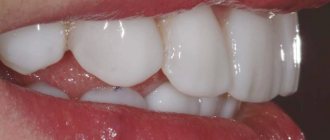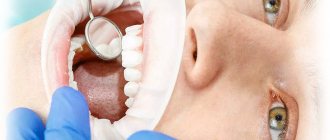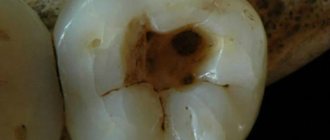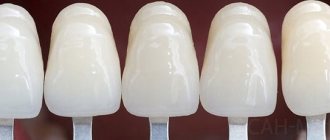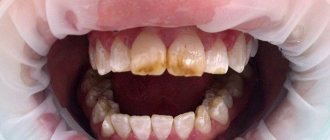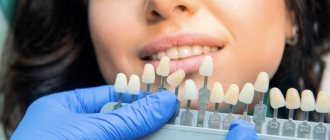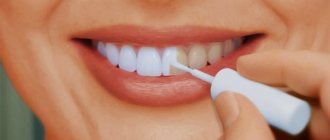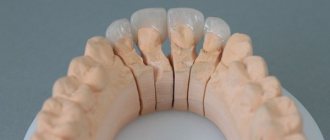Dental enamel implantation is a new and progressive direction in aesthetic dentistry. The essence of the procedure is to restore the enamel coating by fixing special orthopedic devices - veneers - to the front of the teeth. These are thin plates made of ceramics that are used to correct the color and shape of teeth.
In addition to the fact that the thickness of the coatings is only 0.3-0.6 mm, veneers are similar in elasticity and strength to natural enamel and act as an infallible tool for giving teeth exemplary evenness and aesthetics. Installing veneers helps eliminate curvatures, hide pigment spots, chips, cracks and a number of other defects that have appeared on the surface. Although ceramic plates do not provide a therapeutic effect, they improve the appearance of teeth and make a smile impeccable.
Causes of enamel destruction
There are quite a lot of factors that destroy enamel. The most common ones are:
- Poor oral and dental hygiene.
- The use of hygiene products containing aggressive substances that cause demineralization of enamel.
- Disruption of the digestive system.
- Abuse of sweet, sour foods, which chemically affect the top layer of enamel.
- Systematic consumption of energy drinks.
- Smoking. Tobacco contains nicotine, which destroys enamel.
- An incorrect bite causes the tooth enamel to wear away.
- Injury to teeth.
Why you should get veneers
Implantation of enamel coating can eliminate functional and cosmetic defects and give a person a charming Hollywood smile.
The advantages of installing ceramic plates are undeniable:
- reliable protection. With minimal grinding, teeth receive a wear-resistant and durable protective coating;
- invulnerable aesthetics. The thinnest plates fully reproduce natural enamel due to the increased light conductivity of the material;
- versatility. An extensive color palette makes it possible to choose a shade that is in no way different from the color of neighboring healthy teeth;
- quick effect. You can get a dazzling smile in a couple of visits to the dentist, bypassing long-term wearing of braces and other painful procedures;
- durability. If the rules of care for structures are followed, they retain their original appearance for up to 15 years or more.
The specialists of our clinic in St. Petersburg install veneers with a quality guarantee. Regardless of congenital or acquired defects that need to be eliminated, doctors guarantee success in the most difficult situations.
Benefits of implantation
The main advantages include:
- The ability to restore tooth enamel at different degrees of destruction.
- Teeth regain their natural smoothness and shine.
- Strengthening dental health from exposure to external irritants.
- Prevention of the development of dental diseases, especially caries.
Indications for the use of enamel implantation:
- damage to the enamel, disrupting the aesthetics of the tooth;
- decrease in the level of minerals and salts in tooth enamel;
- development of pathology, accompanied by the appearance of spots on the enamel;
- expansion of interdental gaps;
- malocclusion.
Fixed prosthetics with veneers: installation features
Artificial enamel substitutes are a winning option for solving problems with increased abrasion and deterioration of the color of the natural enamel layer, abnormalities in the outline and location of teeth and other aesthetic defects.
The procedure is painless and occurs in several stages:
- preparation for prosthetics. If necessary, the doctor removes carious formations, renews previously installed fillings, and performs sanitation of the oral cavity;
- then impressions are taken from the jaw and sent to a dental laboratory for the production of plates;
- finished structures using durable dental glue are fixed to the surface of the teeth being restored.
After fixation, the doctor checks the correctness of the bite and evaluates the accuracy of the contact of the implanted units with the adjacent teeth and those located on the opposite jaw. If inconsistencies are identified, adjustments are made. At the end of the procedure, the doctor removes excess adhesive.
Enamel implantation does not cause pain and does not require the use of anesthetics, therefore it is suitable for patients with allergies to painkillers. In addition, a healing abutment is not required for enamel implantation.
Other ways to restore enamel
- Filling, which is prescribed in the complete absence of a layer of enamel. The filling material is applied in a thin layer to the tooth, and after hardening, the chewing element takes on a healthy appearance with smooth and shiny enamel.
- Fluoridation. This is the most famous and accessible method of restoring enamel, in which a substance containing fluoride is applied to the teeth. Fluoride comes in gel form. After fluoridation, teeth become smooth and shiny.
- Microprosthetics, when a veneer or lumineer is attached to damaged teeth. The procedure is effective, but expensive.
- Remineralization. A procedure in which calcium phosphate is applied to the teeth. Over time, the applied substance becomes durable and is able to protect teeth from external irritants. This method of restoring enamel is used only when it is partially destroyed. If there is a complete absence of enamel, the method is not effective.
At the first signs of tooth hypersensitivity, you should immediately contact a dentist, who can determine the cause of tooth hypersensitivity. After diagnosis, the doctor will prescribe a course of treatment.
How much does tooth enamel implantation cost?
Dental enamel implantation is a relatively expensive pleasure. The cost of restoration of one unit varies from 14-15 thousand rubles and more, depending on the material and technology for making veneers. If there is a complex defect, the price of cosmetic prosthetics increases accordingly.
Prices for the installation of turnkey ceramic onlays differ from the cost of a dental implant and are calculated for each patient separately, taking into account a number of factors:
- type of material used for the manufacture of plate products;
- method for creating orthopedic products. Onlays can be made from composite or filling materials directly in the orthopedist’s office, as well as in a denture workshop from ceramics or zirconium;
- the number of problem units in need of restoration;
- complexity of the preparatory process;
- scope of work of the implantologist.
Although the designs belong to the upper price category, their superior characteristics and durability fully justify the costs incurred.
Make an appointment
Price issue
| Method | Price (in rubles) |
| Fluoridation | Glubokoe - from 1200 Simple 1 tooth - from 300 |
| Remineralization | 1 jaw – from 1500 |
| Restoration with filling material | From 1000 |
| Veneers | From 10000 |
| Lumineers | From 25000 |
| Implantation | From 10000 |
The price of covering teeth with white enamel in dentistry
The cost of tooth remineralization in dental clinics is determined, first of all, by the severity of enamel damage and the type of fluoride-containing drug used.
The average cost of processing 1 tooth is 150-200 rubles.
If a patient is indicated for deep fluoridation, the cost of the procedure increases to 700-800 rubles.
The most expensive is enamel implantation - the cost of covering 1 tooth, on average, is 4,500 rubles.
Fluoride varnish
The composition of the varnish, which protects tooth enamel and prevents calcium leaching, includes:
- sodium fluoride;
- shellac;
- fir balsam;
- chloroform;
- ethyl alcohol, etc.
All these substances act in synergy - they provide high-quality disinfection of the treated surface and effectively strengthen it. When enamel comes into contact with sodium fluoride, a hard protective layer is formed. It is thanks to him that the unit ceases to be overly sensitive to salty, spicy and sour foods, and temperature changes.
The mixture has a positive effect on the condition of the gums. After its use, soft tissues become less inflamed and bleed less.
What drugs are used for the procedure
Most dentists that offer this technique today use the drug InnoDent1, developed about four years ago. It is interesting that the product is positioned as Swiss, although in fact it was invented by a Kazakh scientist and biotechnologist. According to the creator, Swiss raw materials are used for the production of InnoDent, so the information is partly true, but on the other hand, this is a kind of marketing ploy. Today, about 40% of the product is sold in Kazakhstan, and 60% goes abroad, mainly to Russia and Ukraine.
The drug contains an analogue of the human protein amelogenin. According to the manufacturer, it is this substance that promotes the formation of enamel. Interestingly, amelogenin is absent from already destroyed tissues, and, in fact, by applying the product to the teeth, doctors simply start the process of their natural restoration. The mechanism of action of the active component is as follows: it interacts with human saliva, due to which a regular crystal lattice of calcium and phosphate minerals is built on the surface of the tooth.
Swiss raw materials are used for the production of InnoDent
The manufacturer emphasizes that the use of InnoDent will not give an instant result, which, for example, can be achieved by performing direct restorations with composite material. The process of tissue regeneration is slow, and you need to be patient and wait about a month, but the areas of enamel restored with this drug have natural strength, shine and natural color.
What is tooth augmentation?
Dental augmentation is a dental procedure that allows you to restore the appearance of teeth and restore their lost functionality. A type of extension is artistic restoration - a technique for restoring the front teeth.
Both procedures are performed using special materials that are visually similar to the texture of natural enamel. The restored unit has the same shade and texture as natural dental tissue, is highly durable and lasts for at least 10 years.
Reviews
Feedback from all patients, without exception, about remineralization therapy carried out in the dental office is positive - tooth sensitivity noticeably decreases after the first procedure. The effect of enamel remineralization at home may be less pronounced if the patient does not follow the rules for its implementation.
Reviews about the use of varnishes and enamels for teeth that have a whitening effect at home are not so clear. Many consumers who have used these products on their own report a negative result - the drug is difficult to distribute evenly over the entire surface of the teeth.
Only a dentist can guarantee the high efficiency and safety of covering teeth with artificial enamel. When performing this procedure in a medical institution, not only the algorithm of necessary actions is followed, but all possible risks for the patient are taken into account.
How to apply?
Despite the wide range of such products, they all have one thing in common - the method of application .
It is best to start applying the product by first installing the retractor, after which the following steps should be taken:
- Before application, it is necessary to prepare the crowns by thoroughly cleaning them with a brush and paste to remove plaque.
- After this procedure, you should thoroughly dry the surface of the teeth , otherwise the paint will not adhere well. You can use paper or cloth napkins for this.
- The product must be shaken vigorously and applied to the crowns . The principle of coating in this case is not much different from applying decorative varnish to nails. The movements go from the gum line to the cutting edge.
- After application, you need to wait for the varnish to dry completely . On average, this period lasts 2-5 minutes. Do not close your mouth until the varnish is completely dry.
To maintain the effect for the stated 12 hours, it is not recommended to eat solid food or brush your teeth during this time.
Artificial enamel: scientists have come up with a salvation for those who are afraid to have their teeth treated
It's surprising how many scientific discoveries go unnoticed amid the news noise. Articles about giant insects allegedly found on Mars or another asteroid “bringing death to all living things” fill the information field, while truly important and interesting messages remain in the shadows. This is what happened with the work of Chinese technobiologists, who came up with no less than a simple way to quickly restore tooth enamel. Read more in the column of our columnist Nikolai Grinko.
Photo: depositphotos/IgorVetushko
In fact, tooth enamel is the hardest substance that can be found in the human body. And at the same time, it can grow only during the development of teeth. After a tooth is fully formed, its cells stop secreting special proteins, which, when hardened, form enamel. And there is some kind of universal injustice in this: the teeth of an adult lose their ability to regenerate, and as a result, millions and billions of people suffer from caries. For a long time, the only method of treatment that medicine had come up with was mechanical action: the diseased part of the tooth is drilled out and the resulting space is filled with quick-hardening compounds.
A group of Chinese researchers from Zhejiang University has published a report in which they claim to have invented a method for artificially remineralizing enamel. According to the text of the article, scientists have created a material consisting of clusters of calcium phosphate ions, which can be used to obtain a layer - a precursor to enamel. Simply put, it is able to “prepare the ground” and start the long-stalled regeneration process.
The new material is a gel-like substance that the researchers applied to human teeth (the material for the experiment had to be requested from a local dental clinic). The nano-sized crystals contained in the composition very quickly grew into natural enamel, forming a hard layer 2.8 microns thick in just two days, and it was impossible to distinguish it from real enamel.
This is, of course, far from a complete victory. The actual enamel layer of a human tooth must be several hundred times thicker, but the researchers say that to achieve the desired result, you just need to apply new layers as many times as necessary. Biologists continue to conduct experiments, since any new technology requires careful testing. This process is not very fast - tests on living teeth growing in the bodies of human volunteers will begin only in a couple of years.
There are statistics according to which dentists and dentists make up the vast majority of all doctors on the planet (excluding nursing staff). And this is not surprising, because, according to the same statistics, more than 90% of the world's population suffers from dental diseases. What will happen to this army of doctors if Chinese biologists prove the validity of their discovery?
Photo: depositphotos/DmitryPoch
It is quite possible that the new method will be used only in clinics, then dentists will not be left without work. But if it turns out that the regenerating composition can simply be added to toothpaste, then humanity will no longer need the services of dentists. It looks like a major shift is brewing in the healthcare job market.
Although…
Advantages and disadvantages
Experts attribute the following factors to the advantages of the technique:
- high aesthetics;
- elimination of cosmetic defects of any complexity;
- possibility of bite correction;
- return of soft tissue protection;
- painlessness;
- durability, restoration can last until the end of life.
The only disadvantage of implantation will be its high cost, compared to other restoration options. This is an innovative method of recovery, and it has no categorical contraindications or significant disadvantages.
Causes of development of tooth enamel erosion and methods of treating pathology.
Come here if you are interested in how dangerous cracks in tooth enamel are.
At this address https://www.vash-dentist.ru/protezirovanie/nesemnyie-p/stiranie-zubov.html we will talk about the treatment of pathological tooth abrasion.
When is it worth getting a tooth augmented?
Sometimes, patients don't even realize how a small procedure can change the aesthetics of their smile. Most often, this happens if there are gaps between the teeth. Diastema is an indication for tooth augmentation, but there are also more complex cases:
- chips and cracks;
- injuries;
- fractures;
- pathological abrasion;
- destruction of the coronal part (partial or complete).
How much does the drug cost at the pharmacy?
Fluoride varnishes, which can be used at home, can be purchased in stores and pharmacies specializing in the sale of dental materials.
The price of these products depends on their composition and manufacturer:
- Fluoride varnish (25 g bottle) – 230-250 rubles;
- Dental Paint varnish (10 ml bottle) – from 2000 rubles;
- White Enamel enamel (6 ml bottle) – from RUB 2,300;
- Color Professional enamel (pack of 6 ml) – from 2000 rubles;
- Celebrity white flash polish (pen bottle 3 ml) – 500 rub.
All of the above products, except for the drug "Fluorovarnish", allow you to temporarily whiten the surface of your teeth.
The cosmetic effect lasts for 12-24 hours and disappears when drinking carbonated drinks, solid foods, or after brushing your teeth.
Indications and contraindications
Recently, dental varnishes have become in demand.
Their use is considered appropriate for the following indications :
- the presence of carious lesions at the spot stage;
- enamel hypersensitivity;
- surface microdefects;
- high permeability (thinning) of enamel;
- pigmentation of crowns as a result of consuming coloring products, bad habits, or after taking certain medications;
- fluorosis;
- pulp diseases.
The use of varnish allows you to temporarily solve the problem of color mismatch between fillings and the main surface of the tooth.
The use of correctors is not always possible. contraindications for this :
- age up to 19 years;
- intolerance to components;
- allergic manifestations;
- period of pregnancy and breastfeeding;
- for some types of varnishes – high sensitivity of enamel;
- severe damage to crowns: carious cavities, large chips;
- pathology of periodontal tissue;
- advanced dental diseases;
- dental injuries.
Types of restoration
Restoration with photopolymers
In case of significant damage, we use imported light-curing polymers with different hardness and particle sizes. You can thoroughly select the shade according to the VITA scale. A wide range of options allows the therapist to precisely select the material to restore enamel on the chewing or front teeth.
When working with the material, the doctor uses aesthetic restoration methods. For example, polymers with macroparticles make it possible to accurately recreate the relief of the tooth surface, down to small fissures. The restoration takes place directly in the patient's mouth: each applied layer of composite is cured with an ultraviolet lamp. The result is that the restored tooth is visually indistinguishable from its “neighbors,” and the restoration completely merges with the dental tissues.
Remineralization and fluoridation
If the enamel is weakened and needs strengthening, we treat the tooth surface with a restorative composition containing fluoride, calcium or other minerals. The medicine helps teeth better withstand an acidic environment and prevents the development of pathogenic microflora. In particular, the method is effective for highly sensitive teeth. The drug forms a thin film on the enamel, which has the functions of strengthening and protection.
Installation of veneers
If we are talking about aesthetic defects in the smile area (most often the upper incisors), we recommend installing veneers. These are thin (0.3-0.8 mm thick) ceramic plates that are firmly fixed on the outer surface of the teeth after preliminary grinding. Treatment is necessary so that the plates look natural on the teeth and do not stick out.
Veneers are permanent structures. Their advantages are durability, color retention, natural appearance. That is, your front teeth will always look well-groomed and beautiful. However, this is the most expensive method, so first consult with our doctor and find out how much it costs to restore tooth enamel in your case.
Is it possible to carry out the procedure at home?
The company that sells the enamel implantation product offers not only drugs for professional use in dentistry, but also products for home use. For example, the InnoDent De-Senz set. This complex is suitable for all people with sensitive enamel, non-carious dental lesions (wedge-shaped defect, erosion, hypoplasia, fluorosis), as well as pregnant and lactating women. The product must be used once, i.e. One application will be enough. The volume of the bottle is enough to treat 32 teeth. After 3 days, sensitivity will decrease, but the maximum effect should be expected only after a month. The result lasts from 9 months to 3 years.
This complex is suitable for all people with sensitive enamel
